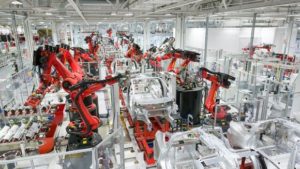In 2018, electric-car company Tesla (NASDAQ: TSLA) set out to go from producing about 100,000 vehicles annually to building hundreds of thousands of vehicles per year. To do this, Tesla would ramp-up production of its 2017-launched Model 3 — its most affordable vehicle yet.
But there are some steep costs involved in growing production capacity and increasing the size of Tesla’s sales, service, and charging network to support rapid growth in vehicle deliveries. This has led to significant cash burn and big losses. To remedy this, Tesla CEO Elon Musk started taking steps earlier this year to do whatever it takes to achieve profitability. Now Tesla is continuing in this direction in one of its biggest cost-cutting measures yet.

Tesla cuts its workforce by 9%
As part of a planned company restructuring that Musk first made light of during Tesla’s first-quarter earnings call, Musk sent a letter to employees this week announcing Tesla was cutting about 9% of its employees.
Tesla has grown and evolved rapidly over the past several years, which has resulted in some duplication of roles and some job functions that, while they made sense in the past, are difficult to justify today.
As part of this effort, and the need to reduce costs and become profitable, we have made the difficult decision to let go of approximately 9% of our colleagues across the company.
Importantly, Musk said there weren’t any production associates eliminated, “so this will not affect our ability to reach Model 3 production targets in the coming months.”
With this restructuring aimed squarely at helping Tesla achieve sustainable profitability, it builds on efforts earlier this year to be “far more rigorous” about expenditures.
Tesla said in its first-quarter shareholder letter that it expected to report positive net income and positive cash flow in both its third and fourth quarter of 2018. But to achieve this, Tesla said Model 3 production would need to ramp-up to a level of 5,000 units per week. With less than a month until its third quarter starts, Musk reaffirmed the company’s expectation to achieve these production and profitability targets during Tesla’s annual shareholder meeting earlier this month.
Why achieving profitability is so important
Without becoming sustainably profitable, Tesla will have to continue habitually raising capital through debt or equity, as it has done in the past. Raising debt would increase business risk and raising equity would dilute shareholder ownership.

Costs for ramping up Model 3 production have been steep. Capital expenditures soared from $1.3 billion in 2016 to $3.4 billion in 2017 — an increase management said was primarily attributable to purchases of property and equipment mainly for Model 3 production. And Tesla expects to spend slightly under $3 billion on capital expenditures in 2018. On the same note, Tesla reported a record net loss in its first quarter of 2018, losing $784 million — far wider than its $397 million loss in the year-ago quarter.
As Tesla ramps up Model 3 production and steps up initiatives to reduce costs, management will need to prove its restructured business can continue growing rapidly while achieving and then sustaining profitability.


